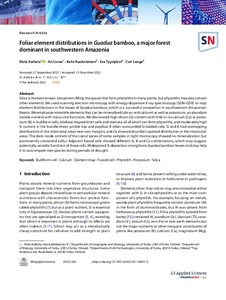Foliar element distributions in Guadua bamboo, a major forest dominant in southwestern Amazonia
Kalliola Risto; Linna Ari; Ruokolainen Kalle; Tyystjärvi Esa; Lange Carl
Foliar element distributions in Guadua bamboo, a major forest dominant in southwestern Amazonia
Kalliola Risto
Linna Ari
Ruokolainen Kalle
Tyystjärvi Esa
Lange Carl
SPRINGER INT PUBL AG
Julkaisun pysyvä osoite on:
https://urn.fi/URN:NBN:fi-fe2022081153850
https://urn.fi/URN:NBN:fi-fe2022081153850
Tiivistelmä
Silica is the best-known component filling the spaces that form phytoliths in many plants, but phytoliths may also contain other elements. We used scanning electron microscopy with energy-dispersive X-ray spectroscopy (SEM-EDX) to map element distributions in the leaves of Guadua bamboo, which is a successful competitor in southwestern Amazonian forests. We emphasize immobile elements that can be mineralized (silicon and calcium) as well as potassium, an abundant mobile nutrient with many vital functions. We discovered high silicon (Si) content with little or no calcium (Ca) or potassium (K) in bulliform cells, bilobate shaped short cells and stomata, all of which can form phytoliths, and moderately high Si content in the bundle sheet, prickle tips and papillae. K often surrounded Si-loaded cells, Si and K had overlapping distributions in the intercostal areas near vein margins, and Ca showed abundant spotted distribution in the intercostal areas. The dark inside content of the costal zones of some samples in light microscopy showed no mineralization but prominently contained sulfur. Adjacent fusoid cells showed different Si, K and Ca combinations, which may suggest potentially variable functions of these cells. Widespread Si deposition strengthens Guadua bamboo leaves and may help it to outcompete tree species during periods of drought.
Kokoelmat
- Rinnakkaistallenteet [27094]
